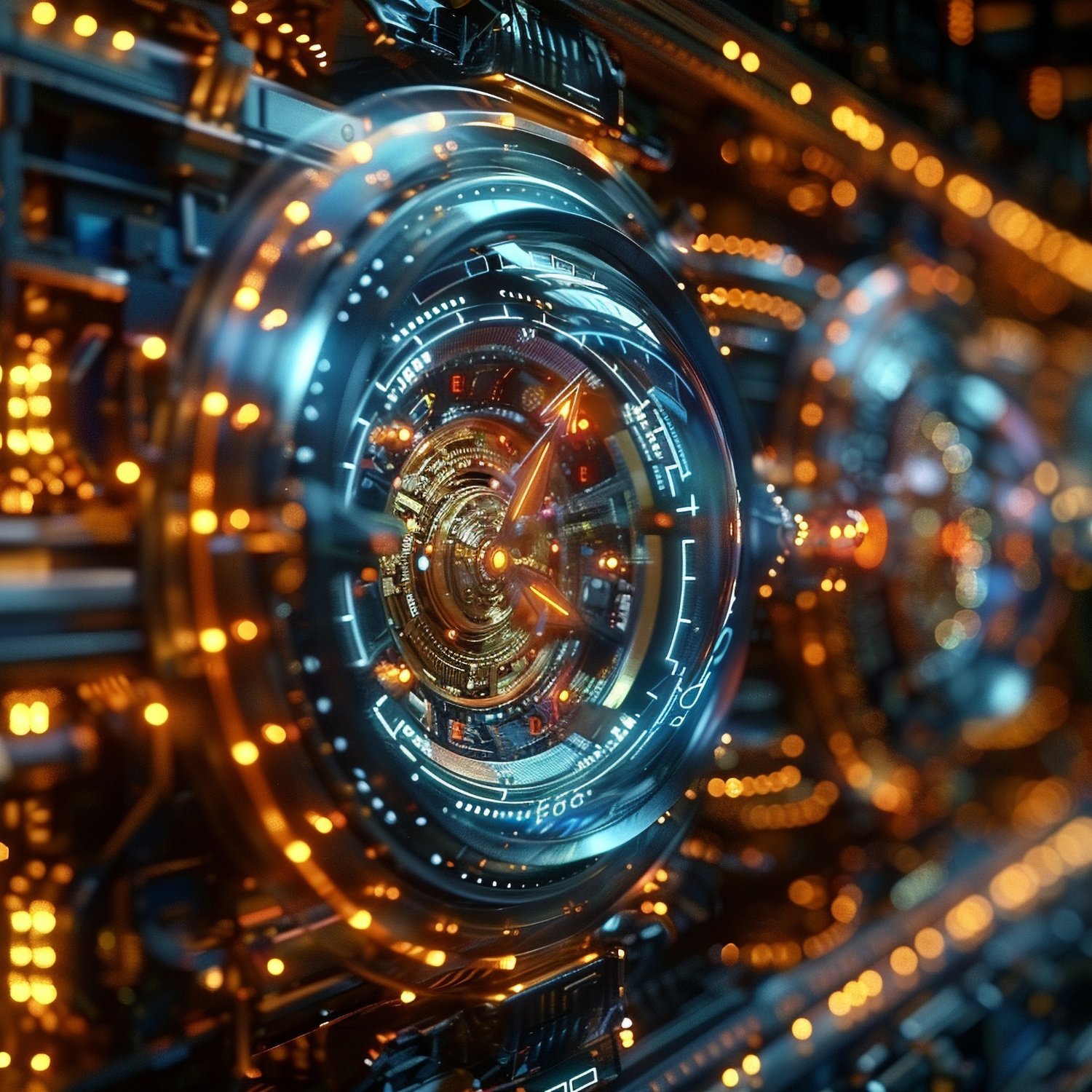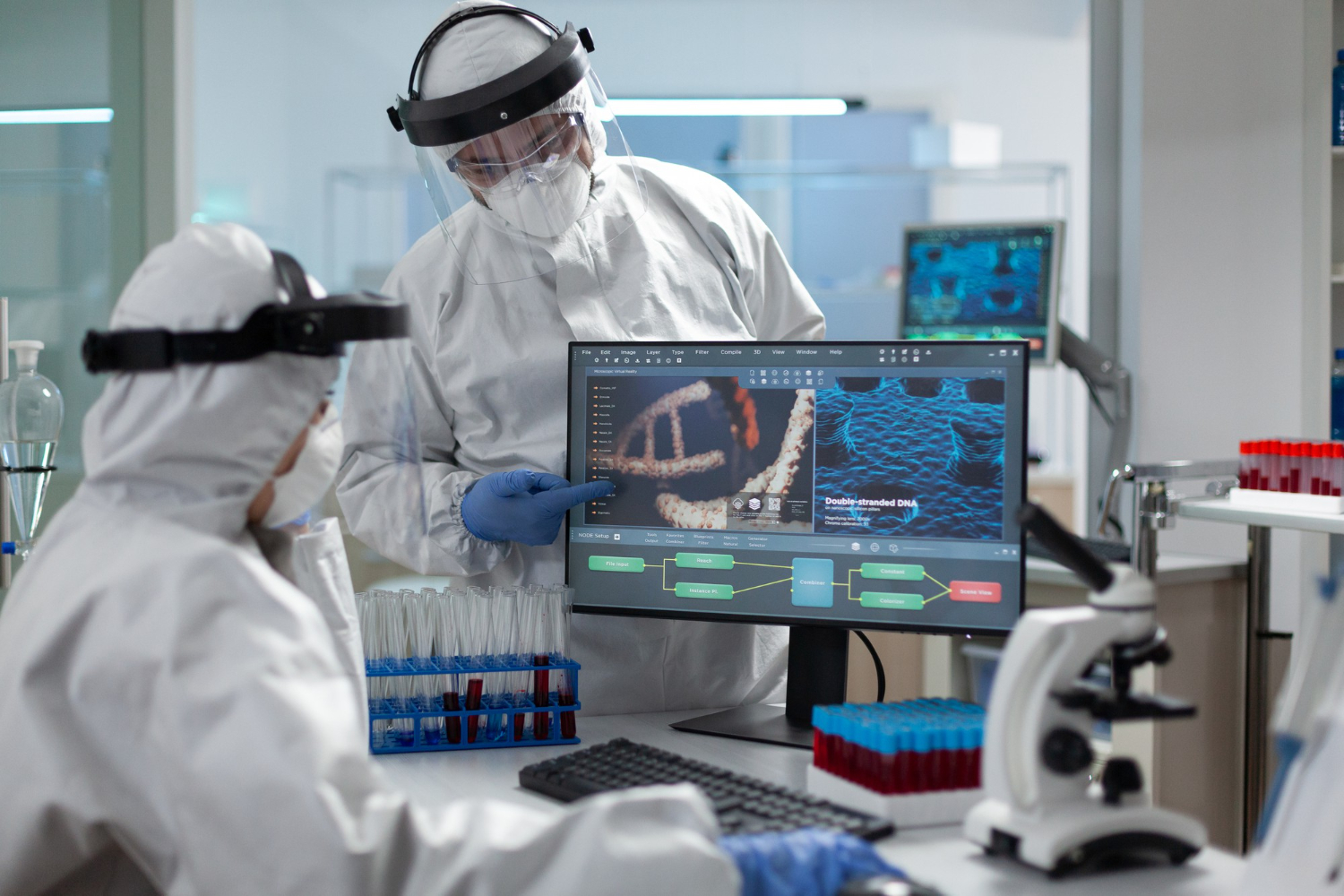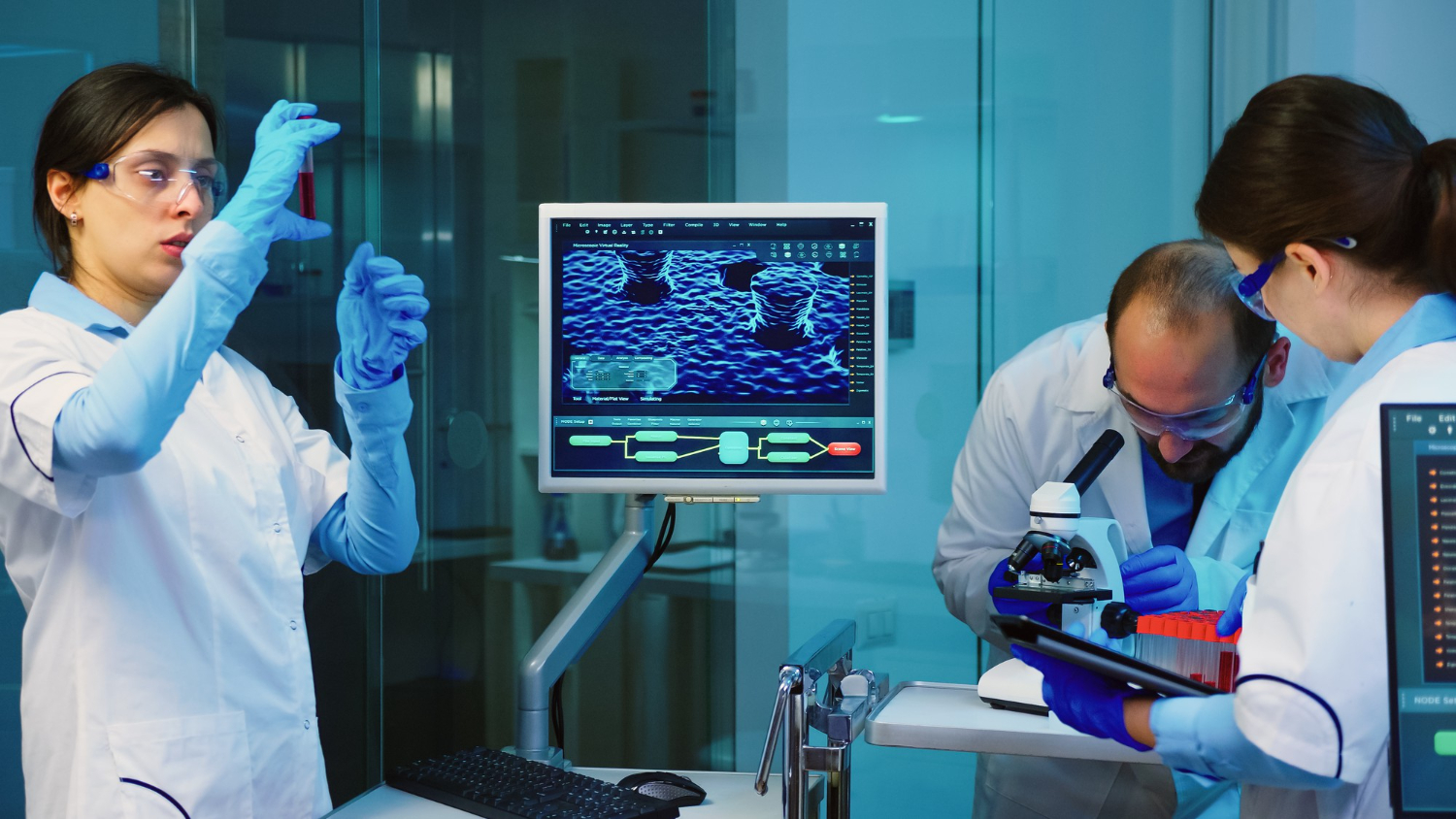Introduction
When there’s a lack of computational resources, enterprises in different industries end up facing issues when creating and running AI applications on their existing systems. Having a less-than-optimal amount of computational power can lead to spending more time training AI models and poor performance with real-time AI applications. These include applications related to computer vision, natural language processing, machine learning, etc. Using AI accelerators can be an apt solution to make AI applications work without any issues or delays.
What are these AI accelerators? An AI accelerator is a high-performance parallel computation machine that is specifically designed for the efficient processing of AI-related workloads like neural networks. The process of using them to speed up AI applications is called AI acceleration. These accelerators can speed up the creation and running of AI neural network models and are a great option for deep learning and machine learning applications.
The global AI accelerator chip market is set up to reach more than 330 billion dollars by 2031. Considering the widespread potential of AI acceleration, it is inevitable that there will be such a rise in the market. AI acceleration can enhance fields like high-frequency trading, medical diagnostics, and vehicle navigation. Also, it can improve surveillance security, manufacturing quality control, and robotic efficiency. The list goes on and on. Where there is AI, there can be acceleration. In this article, we’ll dive deep into AI acceleration, learn different types and techniques of AI acceleration, and explore some applications where it is most useful. Let’s get started!
Understanding AI Acceleration
AI applications can be bogged down by the sheer volume of information they need to process. Creating generative AI tools like ChatGPT would have taken OpenAI much longer without AI acceleration. To put it into perspective, using only CPU processing power, it could have taken decades to develop, making the project nearly impossible. Fortunately, most big tech giants like Apple, Google, and Microsoft use these accelerators to advance AI technology. AI accelerators are specialised software and hardware tools that significantly boost the speed of working with AI, particularly for tasks involving training deep neural networks, running complex machine learning algorithms, and performing real-time computer vision analysis.
While AI accelerators have been around for over a decade, they are becoming increasingly powerful and efficient, making them essential for handling the massive datasets that drive AI applications. These accelerators are now integrated into a wide range of devices, from your smartphone to complex systems like robots, self-driving cars, and even the Internet of Things (IoT). They play an important role in bringing AI to the real world by supporting AI deployments in large-scale applications.
There are two main types of AI acceleration: software and hardware. How are they different? Software accelerators make AI programs run better by fine-tuning them - without needing extra parts. Hardware accelerators are special components designed to handle AI tasks very efficiently. Some hardware accelerators are designed for specific AI tasks, while many can be used more universally. In the next sections, we will learn more about both software and hardware acceleration, providing a clearer picture of how they’re making AI a tangible reality in our everyday lives.

Software Acceleration Methods
Software AI accelerators are tools and techniques that improve the performance of AI and machine learning algorithms without needing extra hardware. They can also make model training and inference much faster and more efficient, often improving performance by 10-100 times. However, these speed improvements can sometimes slightly reduce the accuracy of the results.
The main benefits of software AI accelerators are that they save money by using existing hardware and can be easily added to current workflows. They are also known to use many techniques to optimise AI models. Here are some examples:
-
Quantisation: Reduces model size and computation by converting high-precision numbers to lower-precision integers during training. This technique may introduce some errors, but when used in moderation, a slight drop in accuracy can often be managed.
-
Pruning: Removes unimportant weights or entire layers from a model to make it smaller and faster for inference. Quantisation reduces the precision of the model’s weights, and pruning further simplifies the model by eliminating parts that don’t significantly affect its accuracy.
-
Distillation: Training a smaller, faster model to replicate the behaviour of a larger, more complex model, retaining similar accuracy with reduced computational requirements.
-
Parallel Processing: Splitting the workload across multiple processors or machines to perform computations simultaneously speeds up training and inference
What are the most popular software tools and frameworks used for AI acceleration? Many software frameworks offer toolkits for AI acceleration. They offer pre-built, optimised functions for common AI tasks, saving development time and potentially boosting execution speed. These frameworks also let you customise your AI models through the above-mentioned techniques.
Let’s briefly take a look at some of the major software frameworks used for AI acceleration. TensorFlow, created by Google, excels at optimising calculations and is popular for both research and real-world applications. PyTorch, from Facebook, allows for flexible model creation and is a favourite among researchers for exploring new ideas. It is also frequently used in real-world applications, just like TensorFlow is. Finally, Apache MXNet, known for its efficiency and scalability, tackles both research and large-scale industrial needs where speed and handling big data are crucial.
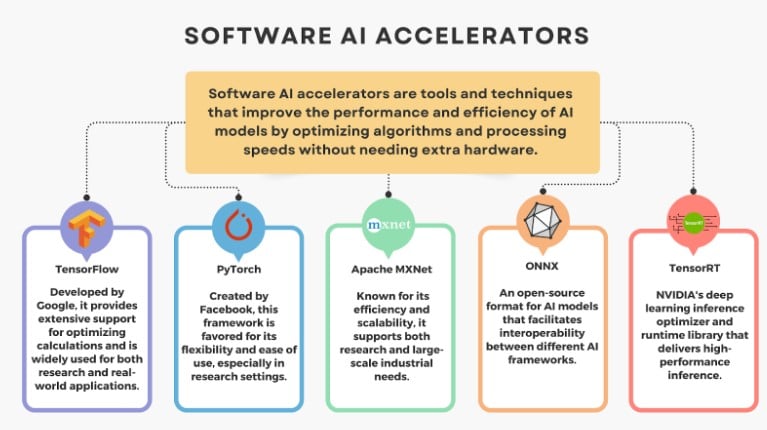
Hardware Acceleration Methods
In the past, there was no way to perform AI acceleration using additional hardware components. Everything was run by embedded software and CPUs. CPUs are definitely a computing workhorse, but it doesn’t have anywhere near the computational power needed to effectively run AI models. Hardware accelerators like GPUs, originally designed for rendering graphics, and TPUs specifically designed for AI tasks are highly effective for AI acceleration. These components allow the system to tackle tasks like image recognition or language understanding much faster than a CPU. Next, let’s discuss the most common hardware components used for AI acceleration.
Graphical Processing Units (GPU)
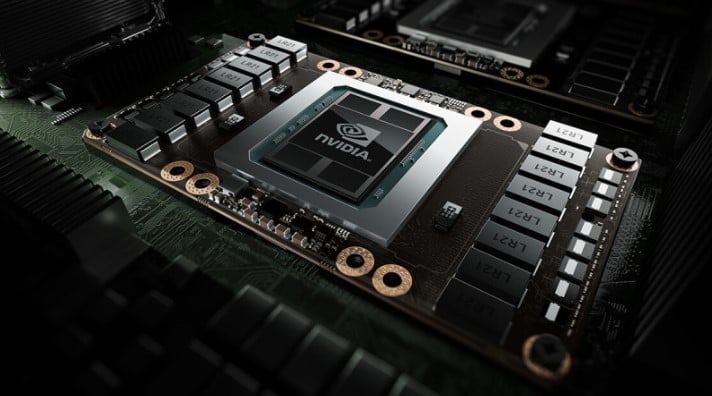
Originally made for image processing, modern GPUs are now vital for AI tasks that handle large datasets. Thanks to their hundreds or thousands of cores, they are great for AI because of their parallel processing capabilities. This ability allows GPUs to work through large datasets and complex math models quickly. For example, machine learning models often deal with large matrices and vectors, and GPUs can handle them efficiently. As a result, GPUs have become essential tools in artificial intelligence.
Field Programmable Gate Arrays (FPGA)
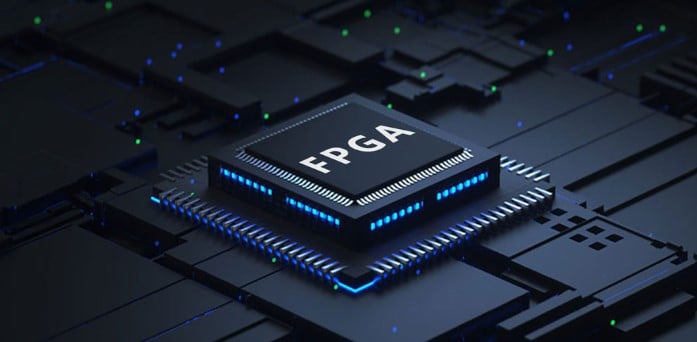
FGPAs were first explored back in the 1990s and are still being used to accelerate machine-learning and deep-learning applications. They are hardware circuits with reprogrammable logic gates. It allows the users/coders to create custom circuits even when the chip is in use (deployed in the field), overwriting the chip’s configurations. Regular chips are fully baked and cannot be reprogrammed, making FPGA-based accelerators far more efficient than other AI accelerators and more flexible because of the programmable components.
Application Specific Integrated Circuits (ASIC)
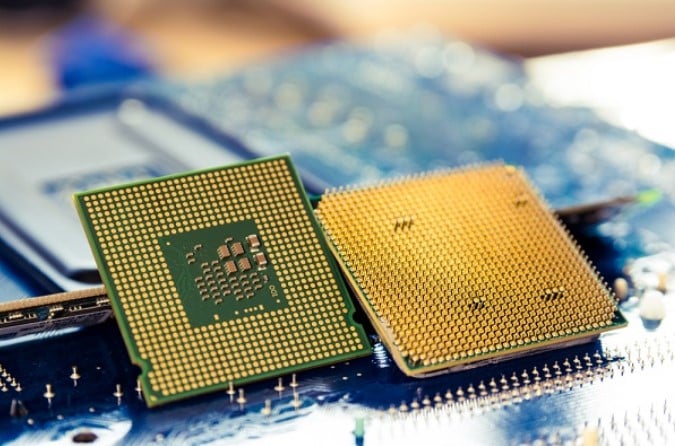
An ASIC is an integrated circuit chip that was made for a specific use, unlike FPGA-based accelerators and GPUs. ASICs are tailor-made for application-specific AI functions. As such, they can be better than FPGA-based accelerators and GPUs in terms of performance. However, an ASIC is very expensive to develop which is a major drawback.
Tensor Processing Units (TPU)
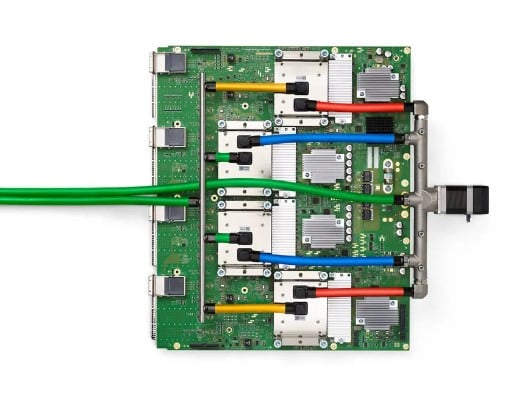
Google’s Tensor Processing Units (TPUs) are custom-made hardware designed to supercharge machine learning tasks. Unlike GPUs, TPUs are built from the ground up for machine learning needs. Their specialised design makes them excel at handling tensor operations, the core building blocks of many AI algorithms.
TPUs also work easily with TensorFlow, Google’s open-source machine learning framework. Google even provides extensive resources like documentation and tutorials to help developers get started quickly with TPUs and TensorFlow. Developers can make use of the speed of TPUs without needing to write complex, low-level code.
We’ve discussed a few options with respect to hardware AI accelerators now. The next logical question that may arise is, of all these options, which hardware AI accelerator is the best for your AI application? For a balance of performance, flexibility, and cost, GPUs are a good choice for various AI and machine learning applications. If you’re working with massive datasets and large deep learning models and prioritise raw performance, TPUs can be very effective, especially in cloud environments. For highly specialised tasks where power efficiency and ultimate performance are crucial, FPGAs might be the way to go but be prepared for a steeper learning curve. Finally, if you have a large budget and specific AI tasks that demand maximum efficiency and performance, ASICs are the best choice.
Here’s a side-by-side comparison of the different types of hardware AI accelerators:
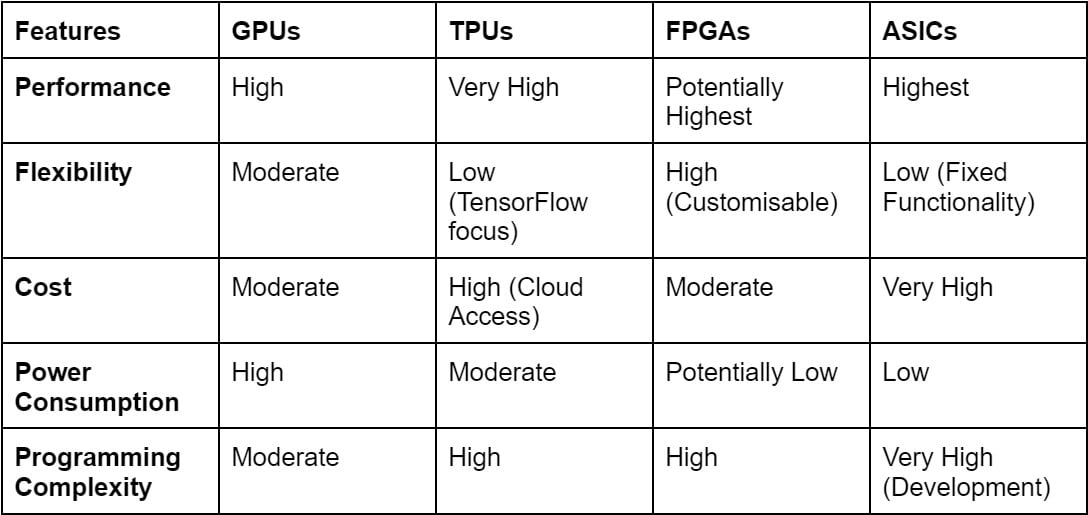
Understanding Where AI Acceleration is Key
Natural language processing is an application in which AI accelerators like GPUs are key factors. NLP uses AI to understand and analyse text or voice data. It includes natural language generation (NLG), which creates human-like text, and natural language understanding (NLU), which understands the context and intent of text to generate intelligent responses.
Making computers understand and respond to human languages has long been a goal for AI researchers. This became possible with modern AI techniques and accelerated computing. Recent advancements in NLP, driven by the power of GPUs, have made it possible to quickly train complex language models. These models are then optimised to reduce response times in voice-assisted applications from tenths of seconds to milliseconds, making interactions as natural as possible. OpenAI’s ChatGPT uses Nvidia’s GPUs for its powerful computing capabilities.
Let’s take a look at some other companies that use AI acceleration:
-
Google: Google’s TPUs accelerate various Google services like search ranking, translation, image recognition, and understanding user queries. Overall, TPUs make Google products faster and more efficient.
-
Alibaba: Alibaba Cloud AI leverages powerful datasets and GPU accelerators to speed up training and use of AI models for their e-commerce platform. AI acceleration helps them to optimise resource usage and handle data-intensive applications.
-
Tesla: Tesla built a supercomputer with thousands of GPUs to train the deep learning models that power their Autopilot and self-driving features. The massive computing power needed for this application lets Tesla engineers develop and improve autonomous vehicle technology more efficiently.
What We Offer As TechnoLynx
At TechnoLynx, we help high-tech startups and SMEs use artificial intelligence to solve their business problems. We understand that integrating AI into different industries can be complex, so we offer a complete service to guide you through the process. Our team of experts can improve your AI models to make them work better and deliver the best results possible. We can also help you manage the large amounts of data that AI needs to function. We always endeavour to create ethical AI solutions that follow the highest safety standards.
TechnoLynx stays up-to-date on the latest advancements in AI and translates that knowledge into practical solutions for your business. Our expertise in different areas of AI, like generative AI, computer vision, IoT edge computing, GPU acceleration, Natural Language Processing, and AR/VR technologies, allows us to create a wide range of solutions. Overall, we help you push the boundaries of what’s possible with AI while keeping these innovations safe and ethical.
Conclusion
AI accelerators help create and run AI models much faster, allowing them to perform complex tasks like image processing and natural language processing. By combining the latest software and hardware solutions, you have lots of options available depending on your needs and budget.
In the future, AI will get even faster thanks to advanced hardware and new technologies like neuromorphic computing (computing that mimics the human brain and nervous system). This will have a huge positive impact on fields like healthcare, finance, and manufacturing. With such AI capabilities, businesses will be able to make decisions and improve their processes in real time. Interested in how AI acceleration can benefit your business? Get in touch with us today!
Sources for the images:
-
Drex Electronics. (2022) ‘Beginner’s Guide to FPGA 2022: What Do You Need to Know?’, Drex Electronics, 15 November.
-
Li, W. (n.d.) ‘Software AI accelerators: AI performance boost for free’, Intel.
-
Norem, J. (2023) ‘Nvidia to Shake Things Up With Its 50-Series Blackwell GPUs’, Extreme Tech, 14 August.
-
Rao, R. (2024) ‘TPU vs GPU in AI: A Comprehensive Guide to Their Roles and Impact on Artificial Intelligence’, Wevolver, 4 March.
-
Szeskin, A. (n.d.) ‘What is an ASIC and how is it made?’, Anysilicon.
References:
-
Cadence. (n.d.) ‘Types of AI Acceleration in Embedded Systems’, Cadence.
-
IBM. (n.d.) ‘What is an AI accelerator?’, IBM.
-
Li, W. (n.d.) ‘Software AI accelerators: AI performance boost for free’, Intel.
-
Research Dive (2023) ‘The Glol AI Accelerator Chips Market to Witness Fastest Growth Due to Robust Demand from the Healthcare Industry and Increasing Usage in Natural Language Processing (NLP)’, Research Dive.

